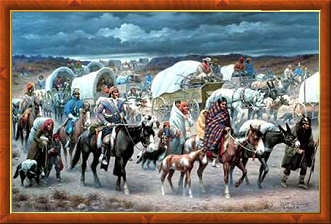|

The Trail of Tears
The Cherokee never ceded title to their
land, but were forced off. This was the Trail of Tears or in Cherokee "Nunna-da-ul-tsun-yi,"
Trail where they cried.
In the summer of 1838, 7000 U.S. soldiers went to remove the Indians.
Two parties were loaded into boats under military guard. Nearly half
died from the heat and unsanitary conditions. Ross petitioned the
government for permission to remove his people over land in cooler
weather and under their own leadership. The request was granted.
Of the 13,000 refugees, over 1000 escaped to the Great Smoky Mountains
rather than leave their homelands. 4000 died, including John's wife "Quatie",
during the winter march of 1838-1839 from Rattlesnake Springs, TN to
Tahlequah, Oklahoma. Once in Oklahoma, John Ross was reelected Principal
Chief. Major Ridge was killed the same day for violating the law
forbidding unauthorized sale of property.
In Tahlequah, Oklahoma land was set aside for schools, a newspaper and a
new Cherokee capital.
October 7, 1861 during the Civil War, the Cherokee aligned with the
Confederacy. A declaration repudiating all treaties with the Federal
Government was ratified. The treaty with the Confederacy, signed by Ross
and Albert Pike, was violated when the Cherokee, led by Pike, were asked
to fight outside their own territory at Pea Ridge, Arkansas. At the
time, it looked to Confederate General Earl Van Dorn like an easy
victory for the confederates because the Union forces were strung out
from Springfield, Missouri to Fayetteville, Arkansas. But when General
Sam Curtis heard from scout "Wild Bill" Hickok that the confederates
were advancing, Curtis consolidated with Davis and Carr to form 11,200
Federal troupes on the high ground at Pea Ridge, just north of Rogers,
Arkansas. The 17,000 Confederate forces achieved some initial victories
on March 7, 1862, in the end they were unable to take Pea Ridge.
The death of his second wife Mary did not deter Ross from attending the
Grand Council of Southern Indians at Fort Smith in September 1865 where
new treaties between Cherokee and the Federal government were prepared.
His own failing health did not prevent him from accompanying the
delegation to Washington where the treaty was signed, July 19, 1866.
John Ross died August 1, 1866 at Medes Hotel on Pennsylvania Avenue.
Ross's dominant ambition was to see the Cherokee become the most
civilized and most educated Indians in the country. John Ross continued
his whole life trying to improve the lot of the Cherokee, his people. It
is for this he should be remembered.
Bibliography:
Trail of Tears by John Ehle, The Rise and Fall of the Cherokee Nation,
Ancher Press, Doubleday 1988
John Ross, Chief of an Eagle Race by Gertrude Mcdaris Ruskin, Official
Historian of John Ross House Association |







